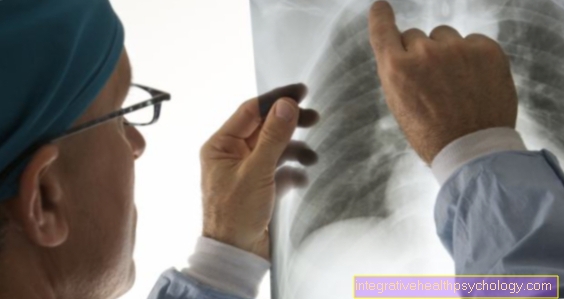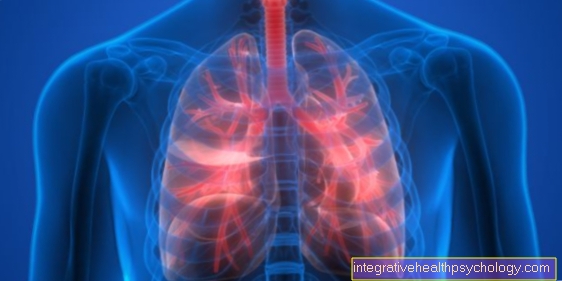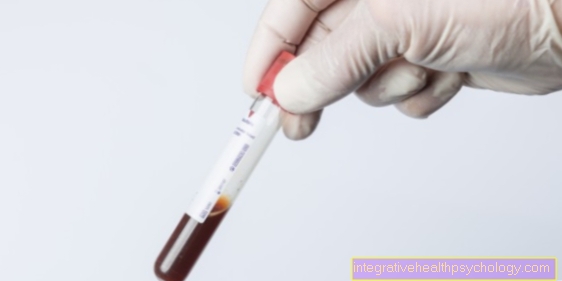Bruised ribs
introduction
Under a bruised rib, too Rib contusion called, one understands an injury to the ribs in the upper body, the bony chest due to a blunt trauma. Internal organs such as the heart, lungs and blood vessels are not damaged by a bruised rib. A rib bruise does not break the ribs, but the tissue over the ribs is crushed. This damages nerve endings in the periosteum and injures small blood vessels. Typical causes of rib bruises are a fall, impact, or severe blow to the chest.

Duration of a bruised rib
The duration of a bruised rib can vary greatly from person to person. In addition to patient-specific anatomical characteristics, the time of diagnosis and the type and intensity of the treatment initiated also play a decisive role in the duration of the bruised rib.
In the ideal case, i.e. with a quick diagnosis and adequate immobilization of the chest, a bruised rib usually heals completely within a period of three to four weeks.
In the case of bruises in the ribs caused by coughing, the time taken for complete healing can be longer. This fact is due to the fact that as long as the cough persists, no immobilization of the chest can be guaranteed. The pressure caused by coughing continues to overstrain the bone-cartilage apparatus. In some cases, the use of cough suppressants can shorten the healing time for cough-related bruises in the ribs. However, these cough suppressants increase the risk of developing pneumonia because the bronchial secretions are suppressed.
In addition, a bruised rib that comprises several ribs and / or is particularly pronounced can take a significantly longer healing time. In severe cases, it can take up to ten or more weeks for complete healing.
Read more on the topic: Duration of a bruised rib
Length of sick leave
In most cases, a sick leave for bruised ribs is initially issued for 1-2 weeks, depending on the extent of the injury and pain. During this period of time, most of the sufferers suffer from complaints so that they can go back to work. If there is more pain after the 2 weeks that makes it impossible to work, the sick leave can be extended to up to 6 weeks.
The length of sick leave also depends on the type of activity. Office work can often be resumed much more frequently than physical work. A sick leave is justified, especially if there is still pain during the work that can hinder the healing process.
What can I do for a short healing period?
Bruised ribs can take several weeks to heal completely and the pain to go away. In order to support the healing process, the bruised ribs should be cooled, this relieves the pain and has a decongestant effect.
Then it is very important to take pain medication so that the inflammation can subside and the sometimes extremely severe symptoms subside. Patients do not take pain medication and breathe less deeply to avoid the pain of deep breaths. The resulting no breathing can have serious consequences. Shallow breathing means that less tidal volume can be absorbed and the lungs are less ventilated as a result. As a result, the gas exchange in the alveoli, during which oxygen is exchanged for carbon dioxide, is reduced and the body no longer has enough oxygen available. The reduced breathing can cause pathogens, e.g. Pneumococci, more easily penetrate the lungs and cause pneumonia there.
Physical protection and immobilization of the trunk reduce the pain and also enable the bruised ribs to heal quickly. In addition, if you have a bruised rib, you should not do any sport, as the increased muscle work improves the blood supply to the injured tissue and thus increases the pain.
Treatment of bruised ribs - what to do?
A bruised rib is treated conservatively, which means that no surgical measure is required for a bruised rib. Cooling (cryotherapy) can help against swelling and pain. Wet towels, cooling packs and ice spray are suitable for cooling. You should wrap the cooling element in a thin towel, as direct contact with the cold can damage the skin.
It is advisable to take a few weeks off and not do any sport. Pain relief ointments and medication such as ibuprofen or diclofenac can also be taken. Ibuprofen is available without a prescription in any pharmacy, although the recommended daily dose of 1200 mg should not be exceeded. If it is taken over a longer period of time (more than four days), this must be discussed with the doctor, as incorrect self-medication can lead to severe side effects. With a bruised rib, the pain lasts for an average of 3-5 weeks, but depending on the degree of injury, it can last longer or disappear after a short time.
If the pain from a bruised rib is particularly severe when breathing in and out, putting on a support bandage can provide relief. In some cases, physiotherapy can also be useful. Massages and heat applications can also help against the pain.
If the bruised ribs are so painful that breathing is severely impeded, prophylaxis against pneumonia may be advisable. Due to the poor ventilation of the lungs and the lack of coughing up mucus, bacteria can multiply very quickly and thus lead to pneumonia. A follow-up check with ultrasound and / or X-rays may be necessary if the pain does not subside even after weeks and there is difficulty in breathing.
Please also read our topic on this Rib block.
The most important remedy for the pain is absolute rest and immobilization of the upper body until the bruise has healed. Painful movements and coughing, laughing and sneezing should - if possible - be avoided. The severe pain, especially when inhaling deeply, can lead to shortness of breath; Doctors call this dyspnea. In such cases, the patient must remain calm and slowly inhale and exhale normally, avoiding deep breaths. Coughing fits are extremely painful and uncomfortable with a bruised rib, so the patient can take expectorant and cough-relieving drops.
Medication pain relief
Symptomatic therapy mainly consists of taking pain medication and anti-inflammatory agents. Ibuprofen, acetylsalicylic acid (ASA) and diclofenac (active ingredient in Voltaren) belong to the group of non-steroidal anti-inflammatory drugs (NSAIDs). These drugs have an analgesic effect and also have an anti-inflammatory effect. Damaged blood vessels can bruise the bruised ribs (hematoma) and cause additional pain. A heparin ointment can be applied locally to the bruise and has a decongestant effect. If the pain is very severe, the doctor may also use non-opioid pain relievers, e.g. Procaine, which numbs the nerves between the ribs.
In addition, cough-dissolving, homeopathic or blood circulation-increasing ointments can be taken as a supplement. The pain is often strongly dependent on movement and pressure, so that painful movements, sports exercises and potential violent effects on the chest should be avoided. Pain relief should be sufficient to provide an acceptable level of pain and allow unrestricted breathing and general movement.
If these funds are not sufficient, so-called "opioids" can also be taken. In addition to pain medication, so-called "antitussives" can be taken. They can block the urge to cough and thus take away the unbearable pain when coughing. To prevent pneumonia, an additional, expectorant drug should be added.
You might also be interested in: How do you treat a bruise?
Anoint
An ointment can be part of the symptomatic pain therapy for a bruised rib. They are very good at relieving the symptoms of bruised ribs and most of them are available over the counter in any pharmacy. Since the ribs are superficially under the skin, an ointment on the skin can bring about a relatively high concentration of active ingredients on the bones. Ointments have the advantage that they can achieve a significantly more targeted effect on superficial injuries without having to burden the entire body with painkillers. For bruised ribs, pain relief ointments with an additional anti-inflammatory component are primarily used. Common ointments for pain relief include Voltaren Gel (active ingredient diclofenac), Traumeel Ointment (a homeopathic ointment with various active ingredients from herbs and plants), Dolobe Ibu Gel (active ingredient ibuprofen) or Dolobe Cool Ointment (a cooling cream with isopropyl alcohol and herbal extracts). The active ingredients come from the group of NSAIDs.
Heparin-containing ointments can also be used less often in the case of bruised ribs with extensive bruises. These inhibit blood clotting under the skin and accelerate the healing process for hematomas.
You might also be interested in: Bruise - treatment and duration of a bruise
Voltaren Emulgel
To treat a bruised rib, the affected area can be creamed with Voltaren Emulgel. It is a cooling gel that contains the active ingredient diclofenac. Diclofenac is a pain reliever and anti-inflammatory agent from the group of nonsteroidal analgesics (NSAIDs) that is suitable for the treatment of acute bruises and injuries caused by blunt trauma. The gel is applied to the bruised ribs twice a day.
Home remedies
The most important therapeutic step in treating rib bruises must be done within the first 48 hours after the injury. During this period, swelling and bruising can develop. Home remedies should provide adequate cooling for the first two days. Initially, cold packs can be used for this, but quark compresses or moist compresses can also be used for this. In the healing phase, which can last several weeks, healing can only be accelerated a little with home remedies.
Primarily, adequate rest and rest should be observed. If you have an urge to cough or have a slimy cold, symptomatic support can be provided with the help of home remedies. Coughing stimuli should be relieved with tea and inhalation in order to reduce the strain on the ribs but also the pain.
homeopathy
Homeopathic medicines are based on the assumption that the body is sensitized to a disease with highly diluted active ingredients and the disease is cured with the help of the body's self-healing powers. Homeopathic remedies can also be taken for bruised ribs to help relieve the symptoms. In the pharmacy there is Traumeel ointment without a prescription with active ingredients from deadly nightshade, monkshood, marigold, arnica and other plants. This ointment is applied to the bruise several times a day. Globules with the active ingredient of the daisy (Bellis perennis) is a common remedy that is used for the homeopathic treatment of blunt injuries.
However, under no circumstances should you avoid taking pain-relieving medication, as a bruised rib could cause serious complications, e.g. pneumonia. If there are breathing restrictions and secondary diseases due to the bruised ribs, homeopathy may only be taken as a supplement to the doctor's drug therapy, but in no way represent the sole therapeutic method. The exact effects of homeopathic remedies on bruises and injuries are controversial.
Read more on this topic at:
- arnica
- Traumeel
Taping for a bruised rib
In order to reduce the symptoms of a bruised rib a little, a kinesio tape bandage is often used in addition to drug therapy. Although this cannot accelerate the healing of the bruised rib (s), it can sometimes make the healing phase more pleasant.
In particular, the breath-dependent pain, which is usually in the foreground with a bruised rib, can be reduced by applying a tape bandage.
As a rule, several strips of the elastic cotton tape are needed to treat a bruised rib. One or more strips are attached along the ribs. Sometimes tape is also attached from top to bottom. The tape should not interfere with normal everyday life and improve the symptoms caused by the bruised ribs. It acts like a second skin and the taped area is fixed without restricting freedom of movement. The tape sticks muscles, massages them and stimulates the blood flow. If this is not the case, the tape can be removed and reapplied. The tapes can either be attached by a physiotherapist, occupational therapist or yourself.
Taping a bruised rib is to be understood as an additional therapeutic measure and should not be used as the sole therapy, especially if there are severe symptoms (see: Pain with a bruised rib). This bandage remains on for a week and should show the main effect in the first three days. Usually such a bandage lasts and works very well, but if there is no improvement or the tapes come off, the tape can be removed and re-attached.
Other treatment options
A bruised rib can be extremely painful. Bruises in the ribs caused by a cough in particular usually lead to very severe pain when the cough is stopped.
For this reason, taking pain killers (Analgesics) is very important in the treatment of bruised ribs. One tablet can be given approximately every 6 hours as needed.
In addition, a bruised rib can be treated primarily by protecting the chest. The affected patient should allow himself absolute rest during the healing time. Any further excessive strain on the chest can make the rib bruise worse.
If the pain is severe, the use of ice packs or cold compresses placed on the affected area can be helpful. In this context, however, it should be ensured that placing an ice pack on the skin can cause severe skin reactions. For this reason, the cooling should not take place directly on the skin surface. If possible, the ice pack should be wrapped in a towel and only then placed on the chest.
If the symptoms persist, the bruised ribs can be treated more extensively. Especially special breathing therapies and / or breathing exercises can help to shorten the healing time for bruised ribs. Periodic, deep breaths should help the intercostal muscles (Intercostal muscles) and effectively treat the bruised ribs.
Some specialist books recommend the use of rib belts and / or compression bandages if the ribs are bruised. It is now assumed, however, that these aids lead to pneumonia in many cases.
Patients who regularly participate in contact sports should wear special protective clothing for a longer period of time even after the bruised ribs have healed. This is the only way to protect the ribs and chest from massive violence and prevent re-bruising of the ribs.
Bruised ribs and cold
As an immediate measure in the event of a bruised rib, it makes sense to cool the chest, as the cold reduces the conduction of pain in the nerve tracts, and less pain is felt.In addition, the cooling ensures that the blood vessels contract so that the swelling after the injury is less.
It is important to carry out the cooling for about 20 minutes so that the effect reaches the depths of the tissue and not only the surface is cooled.
Various options are available for cooling, depending on availability. Cooling can be done with wet towels if no other option is available. Otherwise, cooling pads, cooling ointments or ice can be used.
The use of an ice spray is possible, but does not help with a bruised rib. The ice spray only cools as long as it is being sprayed on and preferably on the body surface.
With all types of cooling, a break should be taken after about 20-30 minutes in order to avoid skin damage from the permanent cooling. In addition, with cooling pads and ice, a towel should be placed between the skin and the coolant to prevent frostbite at this point. The cooling is still sufficient.
After the acute phase it differs whether further cooling or treatment with warmth is more pleasant.
Bruised ribs and heat
Treatment with heat does not make sense in the first 48 hours after the rib bruise, as this leads to an expansion of the blood vessels and promotes the swelling after the injury.
If the bruised ribs were not caused by exercise but by a pronounced cough, many find it pleasant to treat with warm wraps or heat pillows.
The warmth can reduce the urge to cough and supports the healing of pneumonia, for example.
After the acute phase, a heat treatment can relax the muscles cramped by the pain and thus provide relief. Heat therapy also helps by increasing blood flow, as higher blood flow results in a higher metabolism. An increased metabolism means a better supply of nutrients and oxygen to the tissue, which has a positive effect on the healing process of bruised ribs.
Whether heat therapy is perceived as pleasant or not is very individual.
Warmth or Cold - Which is Better?
Many affected ask themselves what works better with a bruised rib - heat or cold? In general, it can be said that both measures help with a bruise, but at different times.
As an immediate measure immediately after the injury, the bruise must be cooled. The cold ensures that the vessels contract and that no large bruises can develop. In addition, the cold reduces the transmission speed of the nerves, which means that pain stimuli are less strongly transmitted to the central nervous system and processed. Anything that is cold can be used for cooling, ideally cooling pads, ice or special ointments with a cooling effect.
On the first two days, the bruised ribs should be treated with cold three to five times for at least 15 minutes. Care must be taken that the cooling pads or the ice do not come into direct contact with the skin, as otherwise skin damage can result from frostbite. It is best to wrap the cooling element in a tea towel or a thin cloth.
On the third day after the accident, heat treatment of the bruised ribs begins. At this point the first healing phase is complete and the inflammation has already reduced. Warmth causes the tissue around the bruise to have better blood flow and a better supply of nutrients and oxygen. The blood circulation accelerates the healing process and the warmth also relaxes the muscles cramped by the severe pain. Warm compresses, a hot water bottle or a hot cherry stone pillow can be used for heat therapy. There are also special preparations that contain the natural active ingredient capsaicin (the hot substance from cayenne pepper) and are applied to the bruise in the form of a cream.
Consequences of a bruised rib
A bruised rib is usually a harmless but painful clinical picture. It can be a nuisance for the person concerned for a few weeks, but is rarely associated with serious health problems. In rare cases, however, the bruised ribs can lead to dangerous complications such as pneumonia. Due to the decreased and flattened breathing due to the pain when moving the chest, many find it difficult to breathe deeply and cough.
In older patients in particular, this can lead to pneumonia due to the insufficient ventilation of the lungs and the accumulation of secretions. As a result of the force acting on the ribs, in addition to bruising, so-called “contusions” of the heart and lungs can occur. Swelling of the tissue can cause serious malfunctions of the organs, which can manifest themselves as breathing problems or cardiac arrhythmias.
Exercising with bruised ribs
If you have a bruised rib, you should completely refrain from doing any kind of sport, as this can further worsen the symptoms and the healing of the bruised ribs can be significantly delayed.
For most patients, any kind of sport is not possible just because of their pain, and everyday life is already significantly restricted by the pain.
But even in the case of patients with less pain, it is advisable to take a break so as not to hinder healing. Especially during sport, rapid movement or a fall is possible, which can both trigger the bruised ribs and worsen an already existing bruised rib.
The situation is different with physiotherapy, which in many cases can be positive for the healing process. Especially in severe cases, breathing exercises can help to positively influence the healing process of the bruised ribs by changing the movement pattern.
Breathing exercises are also used to prevent pneumonia, which can occur when the pain makes it impossible to cough up secretions.
In addition, manual therapy can be carried out as part of physiotherapy, which prevents permanent movement restriction - a consequence of the changed body movement and posture caused by the pain. Here, the focus is primarily on the joints of the chest in order to maintain the full range of motion by stretching the capsule of the joints.
Once the bruised ribs have completely subsided, you can slowly start exercising again. Sports such as cycling, swimming and gymnastic exercises are suitable for re-entry. Here you have to stay well below the usual performance requirement in order to bring the body back to the load after the phase of the break.
It is therefore advisable to build up your performance independently before returning to a team sport in order to avoid overloading. For ball sports, martial arts and winter sports, it is advisable to wear a chest protector, as this often causes bruises in the ribs, which can be prevented by this simple measure. After a rib bruise, it is possible that the pain has subsided in everyday life, but reappears during exercise.
In this case, you should wait before starting sport and only start building up your performance when you can no longer notice any pain during light exercise.
Diagnosis
Every diagnosis of a bruised rib begins with the medical history, followed by a physical examination. The doctor will feel the ribs to find a bruise or break. Usually there is a very strong pressure pain where the ribs are injured. If a rib bruise is suspected, it is also important to rule out injuries to other organs and a possible broken rib.
Imaging procedures
In order to diagnose a bruised rib, an X-ray may be sufficient, depending on the severity of the injury, or a computed tomography (CT) may be arranged.
- In the CT, not only the bony structures can be assessed, but also the internal organs, which is not possible with an X-ray image.
- Only the bones can be assessed in the X-ray. It is important to rule out a broken rib, as the broken ribs injure the lungs, which can lead to a pneumothorax. A pneumothorax is a collection of air outside the lungs in the chest. If air enters between the lungs and chest, this air can hinder the lungs when breathing and cause severe shortness of breath. In some cases, a chest tube needs to be inserted.
- In addition, an EKG can be written to rule out an injury to the heart in the event of a bruised rib and the lungs can be monitored with a stethoscope.
Read more on this topic:
- Chest x-ray (chest x-ray)
- Computed Tomography
- Chest drain
How do I distinguish a bruised rib from a broken rib?
There are several ways to differentiate between a broken rib and a bruised rib. This distinction is only of limited relevance in everyday clinical practice. A fracture often requires a longer healing phase and can also be associated with more severe secondary diseases. The treatment of both injuries does not differ, however, since in both cases there is no causal therapy, but only pain relief over the duration of the healing phase.
The easiest way to tell the difference between a fracture and a bruise is to feel the ribs. Almost all ribs can be felt in their full length. Even if the examination is often painful, most fractures can already be identified this way. In addition, there is often a grinding noise when there is external pressure or deep breaths. To confirm the diagnosis, an X-ray or CT scan may be made to clearly show the bones and potential fractures.
Read more on this topic at:
- Broken ribs or bruised ribs
- Broken rib
Symptoms of bruised ribs
In about 80% there are initially no external signs of injury that suggest a rib bruise. Redness and swelling often only appear later. Bruises also form (Hematomas) often only after a few hours.
The pain of a bruised rib is often as severe as a broken rib. The affected area can be painful to the touch. In addition, pain can also occur when breathing, coughing, sneezing and with certain movements. This can lead to a relieving posture and breathing. The pain can last for weeks, sometimes even a few months, requiring treatment.
Read more on this topic:
- Bruised rib pain
- Broken ribs or bruised ribs
causes
Ribs are usually bruised as a result of blunt trauma, for example from falling during sports activities such as skiing or snowboarding.
You might also be interested in: Bruised back
Bruised ribs from coughing
Another possible cause of a bruised rib can be an increased, strong cough. A strong cough occurs especially in the area of the pars sternalis (Share of sternum and ribs) of the chest to an enormous pressure load.
In addition, the cartilage between the inner ribs and the sternum (costochondral junction) in excess. Patients who suffer from whooping cough, pneumonia or bronchitis are particularly at risk of bruising their ribs due to the prolonged, frequent coughing.
Read more on the topic: Pain in the costal arch from coughing
The bruised ribs caused by coughing can be very problematic. On the one hand, patients who experience pain in the chest area as a result of a respiratory infection usually go to a doctor late (after trauma, this happens much more quickly).
On the other hand, when there are pain symptoms in the course of a respiratory tract infection, many doctors assume in most cases that the muscles and the diaphragm are overloaded. For this reason, the diagnosis "Bruised ribs“Often asked very late or not at all. In addition, the treatment of a bruise in the ribs caused by a cough turns out to be very difficult. In such cases, with persistent coughing, real immobilization cannot be guaranteed.
Also read our article: Exercise for coughs
Prophylaxis of bruised ribs
It is difficult to give a general recommendation for prophylaxis that can prevent rib bruises. Rib bruises are particularly common in contact sports. In this case, protectors can help prevent the injury. Bruises caused by strong coughs can be prevented by prophylactic use of cough suppressants.
















.jpg)












